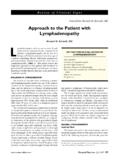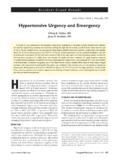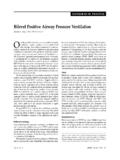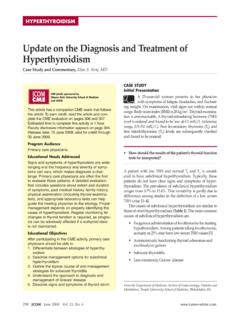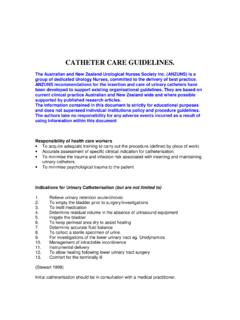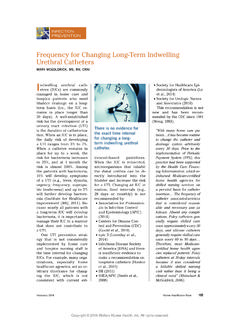Transcription of Management of Urinary Tract Infections in …
1 Rinary Tract Infections (UTIs) in patients withurinary catheters are among the most commoncauses of nosocomial infection and are theleading cause of gram - negative bacteremia inhospitalized in hospitals and nurs-ing homes is greater than 1 million cases each are 1 to million catheter - associated UTIs inthe United States annually, at an additional cost of ap-proximately $400 per episode. This number accountsfor more than one seventh of all UTIs in the article reviews the prevention, pathogenesis,and treatment of UTI in patients with Urinary FOR THE USE OF Urinary CATHETERSThe most effective way to prevent UTI in patientswith Urinary catheters is to carefully identify situationsin which the use of a Urinary catheter is indicated andthereby limit its use to selected patients.
2 General indi-cations for the use of Urinary catheters include the fol-lowing1: Relief of Urinary Tract obstruction Urinary drainage in patients who have bladderdysfunction with Urinary retention (eg, somepatients with neurogenic bladder or spinal cordinjuries) Urologic surgery Strict measurement of Urinary output in critical-ly ill patients Urinary catheters generally should not be used toobtain urine samples or as a substitute for nursing carein incontinent patients, except when intractable skinbreakdown secondary to incontinence is indications are very different for temporary ver-sus permanent catheter use and are listed in Table 1. Incases of acute Urinary retention, the catheter should bemaintained for variable length of time (from as short as3 to 5 days in most males with benign prostate hypertro-phy up to as long as 2 weeks or more), after which avoiding trial should be performed to ensure appropriatebladder 6 Nearly all patients with acute urinaryretention need to be referred to an OF UTI IN PATIENTS WITH INDWELLINGCATHETERSIn a patient with an indwelling catheter, the risk ofbacteriuria increases by 3% to 10% each day that thecatheter is in is therefore inevitable inpatients with long - term Urinary catheters.
3 Infectiouscomplications of catheterization are directly related tochronic bacteriuria and include cystitis, prostatitis, epidid-ymitis, pyelonephritis, lithiasis, sepsis, and ,4 6,8,9 The best way to reduce the morbidity, mortality, and asso-ciated costs of catheter - associated UTI is to prevent orminimize bacteriuria. The source of bacteria in UTIs is the Urinary enter the Urinary Tract through the meatus,migrate to the bladder, and proliferate in the 8 hours of insertion of a catheter, a biofilmcan be found on the surface of the catheter, drainagebag, and mucosa. This biofilm consists of Tamm -Horsfallprotein, struvite and apatite crystals, bacterial polysaccha-rides and glycocalyces, and living bacteria. The presenceof the biofilm is thought to be responsible for the persis-tence of bacteriuria.
4 Prevention should be focused onreducing the entrance and proliferation of bacteria and,thus, slowing the formation of the biofilm. Physicians car-ing for patients with Urinary catheters should follow 2 essential rules: always use a closed collecting system andremove the catheter as soon as it is clinically to decrease the incidence of catheter -associated bacteriuria and UTI have focused on the useof alternative techniques of drainage, nursing recom-mendations, use of different catheter materials and sizes,bladder irrigation, and chronic use of antibiotics. TheCenters for Disease Control and Prevention groups theseUDr. Alcaide is a resident physician, and Dr. Lichtstein is an associateprofessor of medicine and director of education, Department of Medicine,University of Miami School of Medicine, Miami, FL.
5 - Physician August 200429 Clinical Review ArticleManagement of Urinary Tract Infections inPatients with Urinary CathetersMaria L. Alcaide, MDDaniel M. Lichtstein, MDstrategies into 3 categories depending upon the strengthof the currently available clinical evidence (Table 2).1Ad-ditional randomized controlled studies are needed toassess the risk of bacteriuria and UTI in patients utilizingthese techniques compared with indwelling Drainage Techniques Various drainage techniques have been developedto reduce the risk of bacteriuria and UTI in selectedpatients with indwelling catheters. Options include useof intermittent catheterization, use of condom cathe-ters, and suprapubic catheter ,8,9 Intermittent catheterization is the method of choicein ambulatory patients who are able to catheterize them-selves.
6 This technique is widely used, especially in patientswith spinal cord injuries, and also has been used toimprove bladder tone after hip fracture hasbeen shown to reduce the rate of bacteriuria in somestudies. Although intermittent catheterization is a pre-ferred method and is recommended as an alternative toindwelling catheters, no well - designed trials have demon-strated a reduced risk of ,9,11 14 This technique maybe associated with an increased risk of urethral trauma,urethral stricture, epididymitis, and ,8,9,14 Condom catheters may be used in incontinent maleswithout Urinary obstruction and with an intact voidingreflex. Although commonly used, condom cathetersoften fall off and leakage may occur. They may be asso-ciated with an increased risk of UTI, especially whenstrict meatal care is not followed and bag drainage ispoor.
7 The role of condom catheters remains unclear; arandomized trial is needed to compare their use withthat of indwelling catheters. Suprapubic catheters may reduce the rate of infection,but their use is limited mainly to patients on urologic orgynecologic technique is associated with anincreased incidence of bladder stone formation,8especial-ly when the catheter is not changed regularly. Althoughscreening for bladder malignancy by cystoscopy and biop-sy is commonly performed in patients with neuropathicbladder and a suprapubic catheter, this practice has notyet been useful in early diagnosis of bladder RecommendationsVarious recommendations regarding hygiene havebeen proposed to reduce the risk of UTI in catheter-ized patients. Only some, however, have proven to bebeneficial.
8 These include the following1: Catheters should be handled only by personnelinstructed in the aseptic technique of insertionand Management Strict handwashing should be performed be-fore and after manipulating the catheter30 Hospital PhysicianAugust - & Lichtstein : Catheter -Associated UTIs : pp. 29 33 Table for Urinary CatheterizationLong-term catheterizationUrinary obstruction not amenable to medical or surgical treatmentNeurogenic bladder with Urinary retentionIncontinent patient with intractable skin breakdownPalliative care in terminally ill patient to avoid bed changesPreference of a patient who has not responded to specific inconti-nence treatmentsShort-term catheterizationSurgery of the Urinary Tract or contiguous structuresAcute Urinary retentionCritically ill patient when strict Urinary output measurement is neededAdapted from Cravens DD, Zweig S.
9 Urinary catheter Fam Physician 2000;61:369 76. Table Guidelines for Prevention of Catheter-AssociatedUTI (December 1999): Summary of Major RecommendationsCategory I strongly recommended:Catheterize only when necessaryEducate personnel in correct techniques of catheter insertion and careEmphasize handwashingInsert catheter using aseptic technique and sterile equipmentSecure catheter properlyMaintain closed sterile drainageObtain urine samples asepticallyMaintain unobstructed urine flowCategory II moderately recommended:Periodically re-educate personnel in catheter careUse the smallest suitable bore catheterAvoid irrigation unless needed to prevent or relieve obstructionRefrain from daily meatal careDo not change catheters at arbitrarily fixed intervalsCategory III weakly recommended:Consider alternative techniques of Urinary drainageReplace collecting system when sterile closed drainage has been violatedSpatially separate infected and uninfected patients with indwellingcathetersAvoid routine bacteriologic monitoringAdapted from Wong ES.
10 Guideline for prevention of catheter-associ-ated Urinary Tract Infections . Available at Accessed 2 Jun = Centers for Disease Control and Prevention; UTI = urinarytract infection. Sterile technique should be used when insert-ing the catheter The catheter bag should always be connected toa closed system and kept below the level of thebladder Bags should be emptied regularly in a separatesystem for each patientMeasures that have not been proven effective in-clude routine and vigorous meatal cleaning, routinefixed catheter changes (eg, every 3 days), and isolationof patients with UTI in a separate ,14 Catheter MaterialCatheter materials have been evaluated in regard totheir antibacterial properties. Latex, silastic, and silvercatheters are most commonly used.




